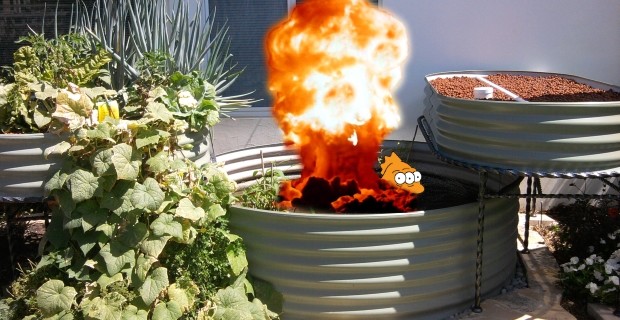A small backyard aquaponic system supplying fish and vegetables sounds like a self-reliance dream, but it can quickly turn into a nightmare. Here is what to avoid to ensure it doesn’t become that nightmare.
Grand Plans, Not So Grand System
Poorly designed and constructed systems are the leading cause of problems in DIY aquaponics systems. When you start planning an aquaponics system you will initially build a plan based on how many fish you want to grow (often a lot!). However as you start preparing to build the system, concessions are often made that result in a less than ideal environment for the fish and plants. Types of concessions that impact the final system build are:
Limitations of Budget
Even for a DIY system the costs can start to add up. Once you start calculating the costs of the fish tank, grow bed tank, grow bed stand, media, pump, and fittings, short/long training courses etc , you might find that the costs are higher than you thought a DIY solution might be.
Space Limitations
Either the area you have set aside is too small to fit a decently sized system or you are forced to install the system in a less than ideal location (too much shade/ too much sun/wind). Location issues are sometimes caused by a perception that the system is going to be ugly, overzealous, and industrial looking, so the area unused is commonly the same to install it, out of sight.
Proving the Concept
Before spending more on a larger or professionally built system, some prefer to build a small test system to prove the concept to themselves. Ironically these small systems are less likely to be successful and often cause the builder to spend more in upgrades, chasing their tails, and over complication of their system via information overloading. Ask a professional not a mate. You don’t want to have enough information to get yourself into trouble and also not enough to get you back out of it. Hence the push to seek professional advice. I am always available to help and consult/design and build.
Logistics
The main logistical challenge is to raise the grow bed above the fish tank in a classic flood and drain system. Grow beds are exceptionally heavy and many reduce the size of the grow bed to make it more feasible to stand it above the ground. This affects the filtration capacity of the system leading to poorer water quality for the fish. This is also the type of information discussed on several aquaponic enthusiast sites. If there is not enough biofiltration in relation to fish, you will surely have an issue either sooner or later.
Limited by available materials
Depending on where you live, there just may not be the supply of suitable materials (fish tank, grow bed tank) for successful aquaponics systems. This leads to purchasing of the closest most suitable materials (that sometimes aren’t suitable) which won’t help you reach the results you are looking for. Always contact a reputable seller. Cheap isn’t always cheap in the long run.
Impatience
Aquaponics definition of ‘Impatience’: The urge to stock a fish tank full of fish on completion of a DIY project or in a new system. “They will be ok for now”. Wrong in several ways but mainly the CYCLING of the System is what is commonly referred to as the engine room of the system. The fish waste is the fuel, The biofiltration (grow beds/filters) are the system filters.
Aquaponics systems need a lot of time ( at least a year) before they can be stocked to capacity, however the urge to stock a new system full of fish has led to a spectacular failure of many an aquaponics system. Please for your own sake, be patient and use this time to seek advice, or come for a consultation/ aquaponics course with me.
Too Many Fish
Overstocking aquaponics systems is a mistake almost everyone makes once. The idea of growing a large stock of fish in your backyard is tempting, with the implication that costs and effort not seeming worthwhile unless you are growing a lot of fish and veg in return. Remembering stocking densities, remembering bio filtration ratios, remembering less is more. As the fingerlings are often very tiny when brought, many folks seems to believe that the system stock advice may be wrong so they often buy more than is needed. Surely these likkle fish cant produce enough so if we get more then we feel good about more fish, more waste, more life. Wrong I am afraid. Stock density is paramount and often overlooked.
Start small: Small fish, Small number. Let your system grow with your fish. Write off your first season and build up fish numbers in future seasons.
Overfeeding
The more I feed my fish the faster they will grow! True in part, however don’t forget the result of more feed….more waste! Unless your grow bed (filtration system) is capable of filtering the excess waste, substances toxic to your fish will accumulate and cause you problems. Ammonia spiking and ultimately more work with either water exchanging, system dumping, system clearing, more grow beds etc either way this oversight can cost you more in the end.
Don’t feed your fish if they aren’t feeding. Throw a couple of test pellets into the water and if they are quickly devoured then it’s fine to feed your usual amount. If the pellets aren’t taken in the first 10-20 seconds it’s likely the fish aren’t feeding so don’t feed them any more.
Lastly, remove uneaten fish foods. Fish feed that sinks will rot on the bottom of the fish tank, and quickly because a problem if it starts to accumulate (Marron can alleviate this issue somewhat) . A bit of feed left on the bottom of the tank for a few days is fine, even if you do a spot check once a week you are not likely to run into problems. Just don’t leave it to build up over time.
Under Care
Aquaponics systems are a mini ecosystem that when established will mostly manage itself. Massive importance on getting a well designed and built system over a cheaper, budget friendly, poorly designed and built DIY version. While your system does a great job of keeping itself maintained it does require some upkeep and care, for example:
Checking for excess algal growth (including inside pipes). Algae will always be around, airborne particles will always find a host. Don’t be alarmed too much with the presence of algae (ANOTHER BLOG WILL EXPLAIN ABOUT ALGAE)
Clearing debris than might get sucked into the pump, be careful of gravel bottoms, always make sure the pump is clear and protected from accidental debris and gravel grabbing.
Removing expired plants and replacing with new seedlings or let self seed or sow fresh.
Over Care
Over care can be as much as a problem as under care. It’s exciting to have an aquaponics system however it’s important to leave it to its own devices in order to setup the natural systems that will manage it in the long term. Cleaning the system (unless absolutely necessary, setting down or relocating) can set back the system and the media in the grow bed should remain undisturbed (definitely no cleaning required despite some suggestions of cleaning your grow bed sediment! This is the catalytic converter so to speak, the Wizard of Oz type ting, we need that bacterial colonisation and microherd to do all the magic, if we wash it we remove it, throwing the whole ecology and life out of sync. Again wasting time, effort and money and most crucial of all LIFE.) If intending to relocate try your best to keep the clayballs in a wet environment to preserve the AMMONIA, NITRITE and HETEROTROPHIC BACTERIA aka BIOFILTER.
The great thing about an aquaponics system is that you need to feed fish daily, sometimes every second day – not including OVER WINTERING. This means that you are standing in front of your system every day and are very likely to pick up on anything that needs to be done.
Blessings, Ras Mark SUBURBAN FARMER

